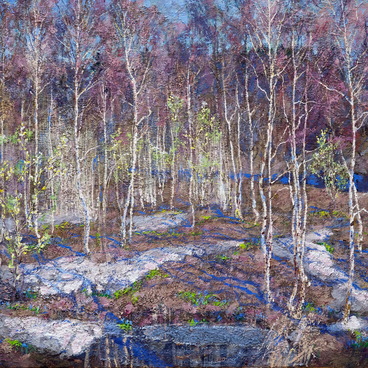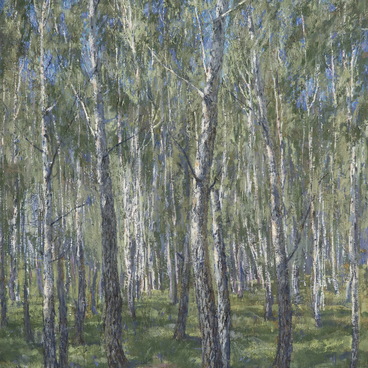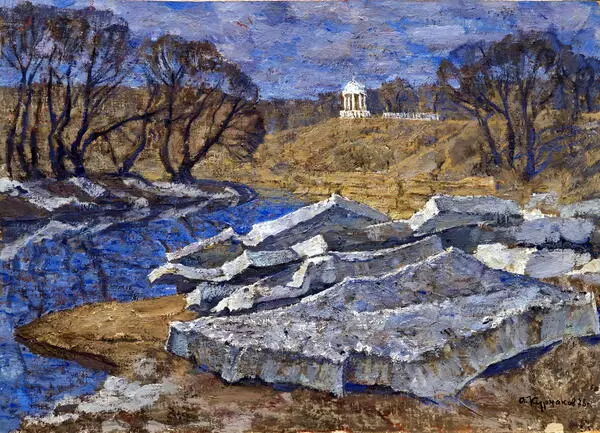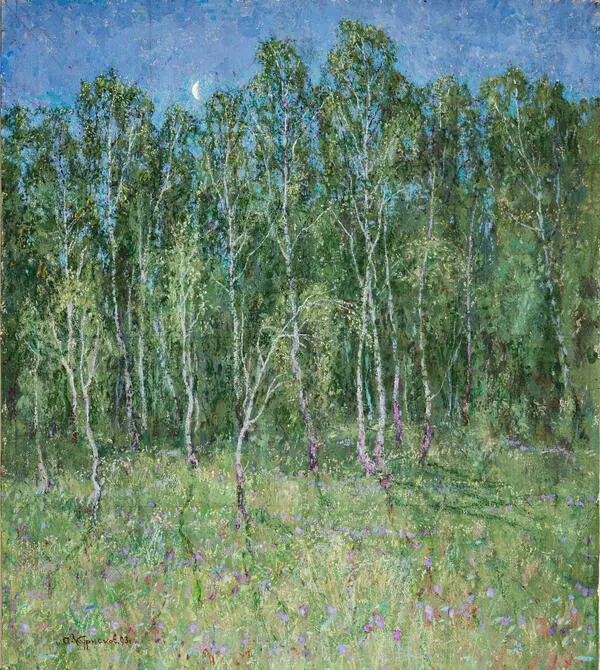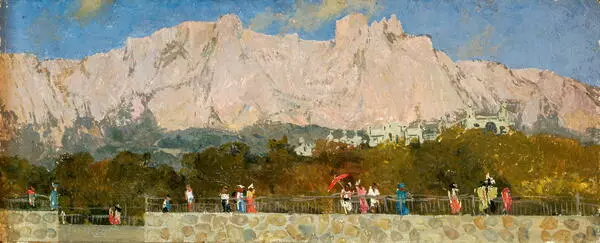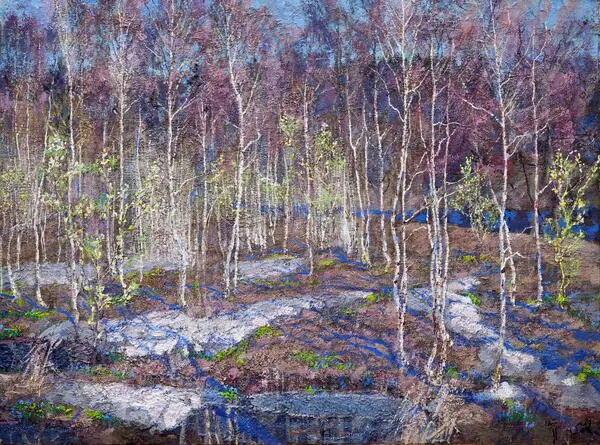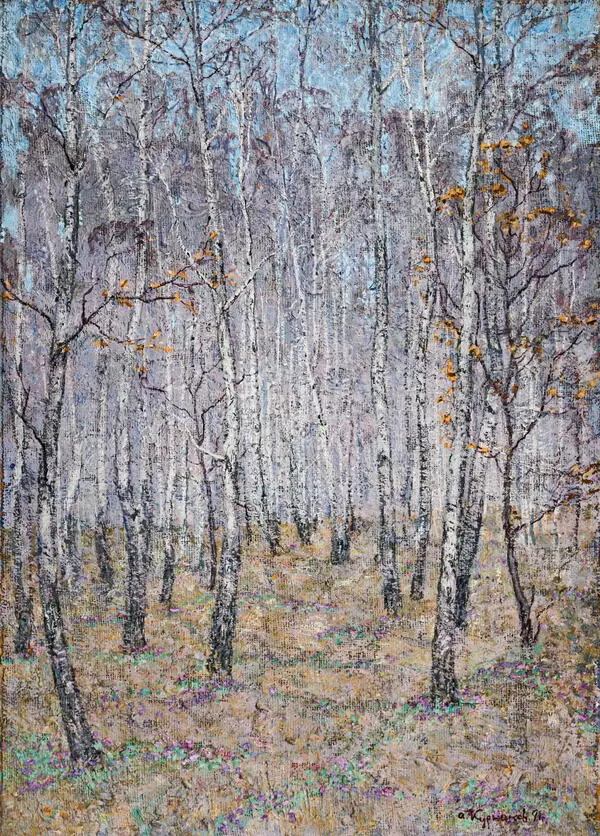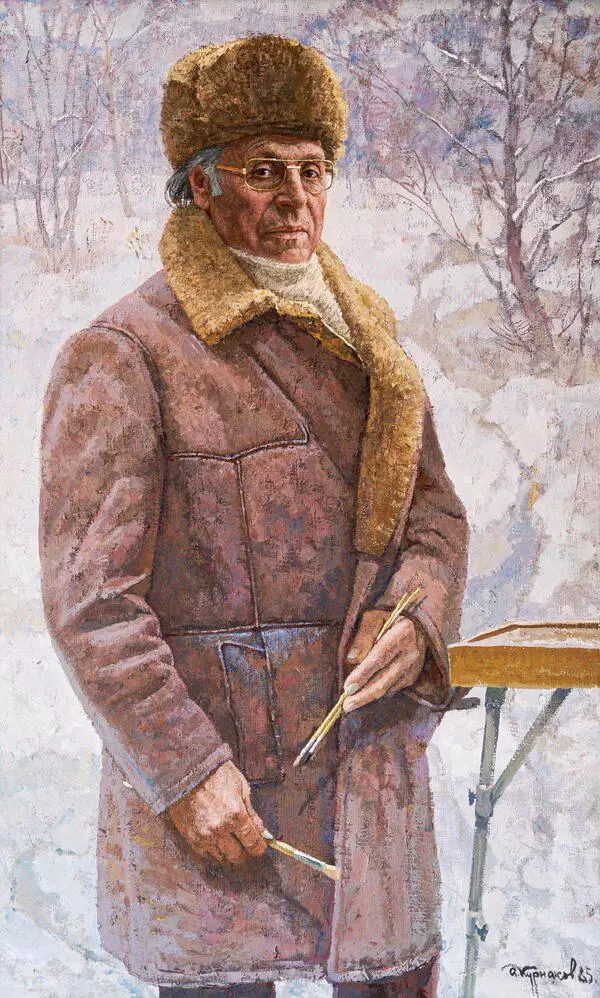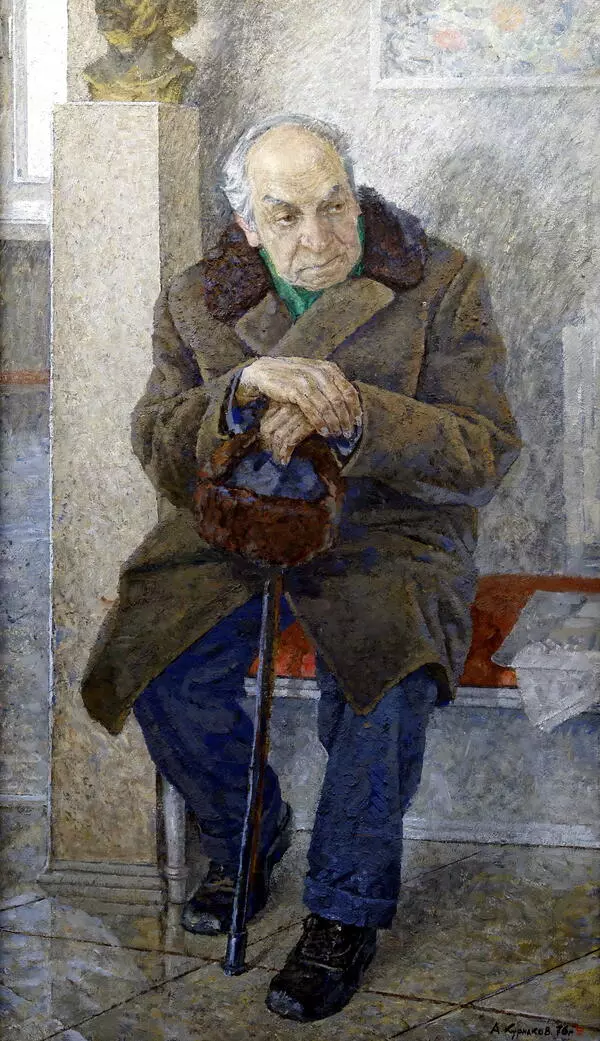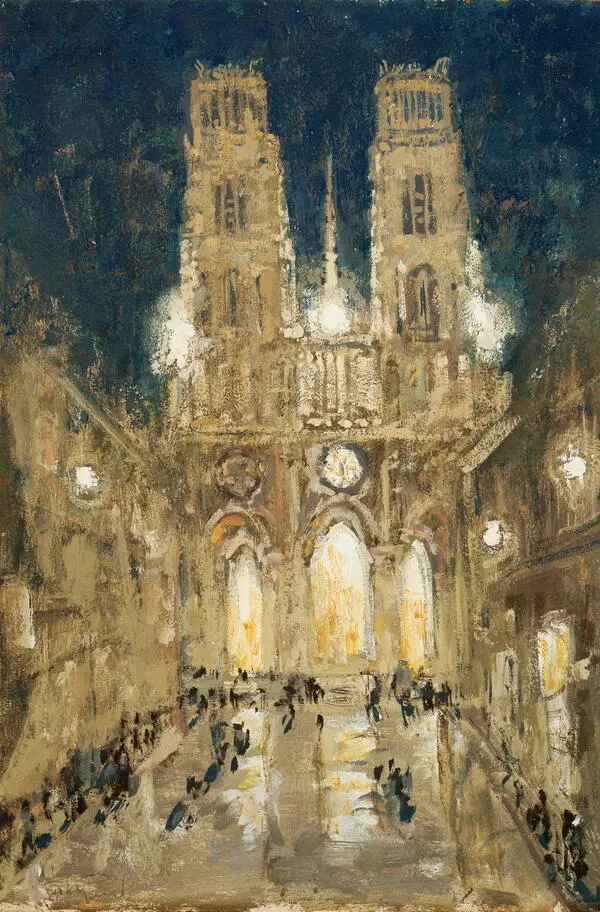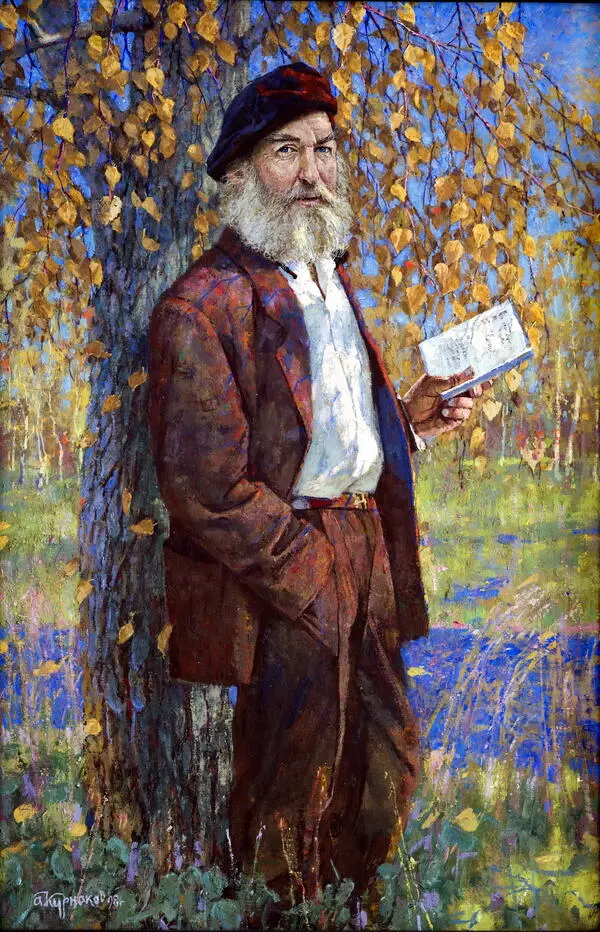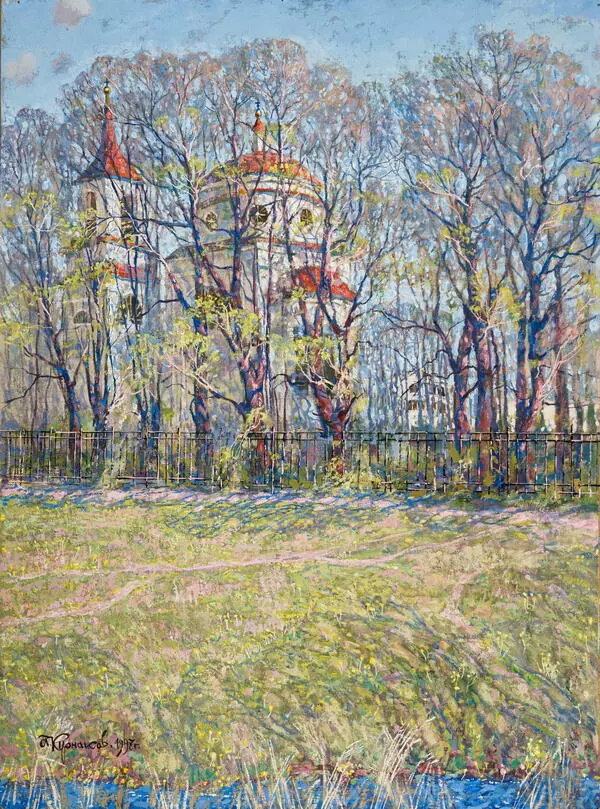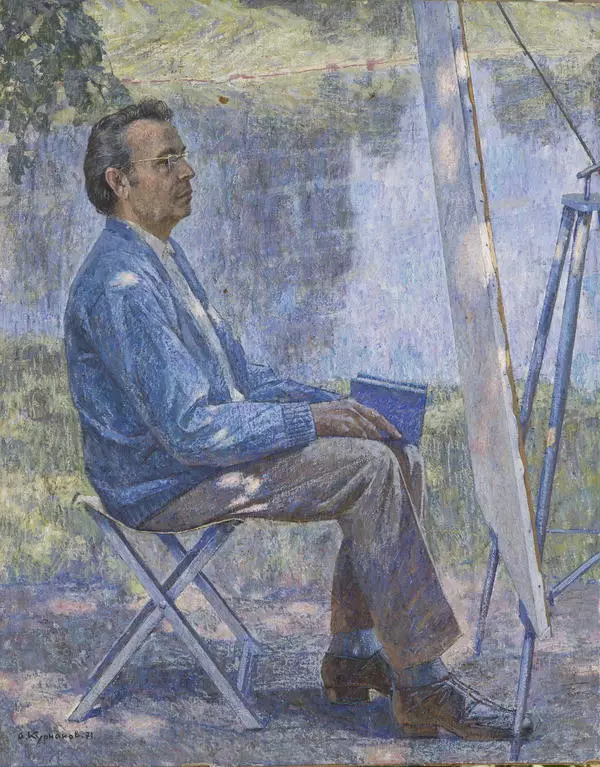The works painted by the artist during this period have a special texture, thanks to the coarse-grained canvas used by the master. They seem to be a little shimmery. In front of us is one of such works.
October. Late fall. The gaze slides from the young birches with lemon-yellow leaves standing in the foreground to a small river with steep banks and a gentle, tender and melodious name Snezhed. The artist painted the cold water in the river with unusual swampy green and purple paints with wide strokes. Calm and smooth water seems to be locked in strong banks. The riverbed is deep, and it does not overflow its shores during the flood. Everything here is moving according to a solid, reliable order that has proven itself many times over. The steep banks in the distance are covered with dark forest approaching the water. With light strokes, the artist denotes spruce, lovingly depicts thin birch trees and their reflection in the river.
Another river flows through the Bryansk region nearby, just a few tens of kilometers away, with a very similar name, a similar mood, like the sister of this river, the difference is only one letter - ‘Snezhet’. Yet how the poetic lines of the Bryansk poet Ivan Abramov resemble the landscape of Andrei Kurnakov.
‘My heart was filled with longing once again,
Maples catch freshness of dewdrops with their leaves.
I touch the cool temples of
Quiet river named Snezhet with my lips.
Little by little the craving leaves the meadows,
And the dawn is trying to close my eyes…
If it hurts again, I’ll press myself on the temples of
My childhood river called Snezhet…’
The banks of Snezhed are surrounded with multiple legends about mermaids and the spirits of the river and the forest: they laugh with silvery laughter and lure good fellows into the river, where they disappear. It is also believed that a girl is standing on the bridge on a full moon; if you tie a red ribbon to her as a gift, she will tell her the name of her betrothed. Therefore, thyme grows on the banks of the river to drive away evil spirits and welcome good ones.
The cloudy sky in the picture is filled with leaden snow clouds. The first snow is shown against the sky as dark purple-violet dots, and elsewhere as light flakes. The whole river seems to be shrouded in haze, soft pastel color transitions give a feeling of moisture, and a folk omen unwittingly comes to mind: “If the snow falls on damp ground and does not melt on the day of the Intercession, then the snowdrops will bloom early and amicably in the spring”.
The work, created in lilac-violet colors, is filled with mystery, some kind of special piercing immateruality. In the unassuming simplicity of the everyday landscape, the artist noticed a special charm, poetry, a certain mood and spirituality. This is late autumn, but there is no dying of nature, no gloom. This is the strength of Kurnakov’s landscapes. The painter’s soul speaks in them - sensitive, quivering, complex.
October. Late fall. The gaze slides from the young birches with lemon-yellow leaves standing in the foreground to a small river with steep banks and a gentle, tender and melodious name Snezhed. The artist painted the cold water in the river with unusual swampy green and purple paints with wide strokes. Calm and smooth water seems to be locked in strong banks. The riverbed is deep, and it does not overflow its shores during the flood. Everything here is moving according to a solid, reliable order that has proven itself many times over. The steep banks in the distance are covered with dark forest approaching the water. With light strokes, the artist denotes spruce, lovingly depicts thin birch trees and their reflection in the river.
Another river flows through the Bryansk region nearby, just a few tens of kilometers away, with a very similar name, a similar mood, like the sister of this river, the difference is only one letter - ‘Snezhet’. Yet how the poetic lines of the Bryansk poet Ivan Abramov resemble the landscape of Andrei Kurnakov.
‘My heart was filled with longing once again,
Maples catch freshness of dewdrops with their leaves.
I touch the cool temples of
Quiet river named Snezhet with my lips.
Little by little the craving leaves the meadows,
And the dawn is trying to close my eyes…
If it hurts again, I’ll press myself on the temples of
My childhood river called Snezhet…’
The banks of Snezhed are surrounded with multiple legends about mermaids and the spirits of the river and the forest: they laugh with silvery laughter and lure good fellows into the river, where they disappear. It is also believed that a girl is standing on the bridge on a full moon; if you tie a red ribbon to her as a gift, she will tell her the name of her betrothed. Therefore, thyme grows on the banks of the river to drive away evil spirits and welcome good ones.
The cloudy sky in the picture is filled with leaden snow clouds. The first snow is shown against the sky as dark purple-violet dots, and elsewhere as light flakes. The whole river seems to be shrouded in haze, soft pastel color transitions give a feeling of moisture, and a folk omen unwittingly comes to mind: “If the snow falls on damp ground and does not melt on the day of the Intercession, then the snowdrops will bloom early and amicably in the spring”.
The work, created in lilac-violet colors, is filled with mystery, some kind of special piercing immateruality. In the unassuming simplicity of the everyday landscape, the artist noticed a special charm, poetry, a certain mood and spirituality. This is late autumn, but there is no dying of nature, no gloom. This is the strength of Kurnakov’s landscapes. The painter’s soul speaks in them - sensitive, quivering, complex.
